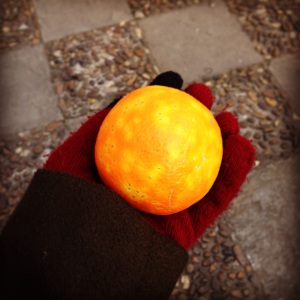Sevilla – orange trees and fish
Sevilla was the first stop on our trip to Andalucia. In terms of food, it was the least exciting, but I loved the architecture and atmosphere of the city. The cathedral was stunning (although almost surpassed by the smaller church Iglesia del Salvador) and the orange trees that lined every street gave off an enticing aroma. I learned the hard way that they shouldn’t be eaten, as I picked one, peeled it, and screwed up my face in horror as I took a bite. It was indescribably sour, and is apparently used for making marmalade. In Granada, I then found out that it’s even referred to as the ‘sour orange’!
 Having said that, every single morning on this holiday started with a glass of freshly squeezed orange juice, which was always stellar. Every cafe, no matter how small or tucked away, had a juicer, and we were never disapointed. Don’t miss out on this morning pick-me-up if you’re in Andalucia!
Having said that, every single morning on this holiday started with a glass of freshly squeezed orange juice, which was always stellar. Every cafe, no matter how small or tucked away, had a juicer, and we were never disapointed. Don’t miss out on this morning pick-me-up if you’re in Andalucia!
On our first night, we decided to eat the typical ‘pescadito frito’, which is, quite simply, fried fish. We had been recommended La Isla, which is a small, crowded, fast-food-style place (a so-called ‘freiduria’). Fish is served by weight, and so we ordered a mixture of species, including the more standard prawns and squid. Our order arrived in paper folded into a cone with no spices or sauces, but potato chips on the side. The fish was good, but a little too greasy for my liking. It is the typical cuisine though, so we were glad we tried it, but we had it again in Granada at Bar Kiki, where it was much better!
 After La Isla, we went to Hotel Eme for a drink on their roof terrace, which had a view of the cathedral. It was a nice place with with an OK view, but the drinks were horrendously expensive!
After La Isla, we went to Hotel Eme for a drink on their roof terrace, which had a view of the cathedral. It was a nice place with with an OK view, but the drinks were horrendously expensive!
The next day, we had the customary orange juice and bocadillo to start the day before taking the free tour around the city. We then headed to Casablanca for tapas, which had also been recommended by a friend. Unfortunately, we were victim to a standard Spanish custom: Tapas are served if you stand at the bar, but if you take a table, you are forced to order ‘real food’. We ordered the huevos estrellados, the typically Spanish dish which consists of fried eggs broken over fries, in this case with the addition of chorizo. I’ve never had ones that rivalled Caramba in Barcelona, but these were not bad. We also had the tomato salad and seafood rice (not paella, more liquidy than that), but overall, it was forgettable. But the ice cream we had at Bolas made up for it…
We kept coming across little shops that sold tea and spices and displayed them in beautiful baskets outside, so I finally got tempted and bought some Darjeeling Castleton tea in Te & Te. I had the first cup of it last night, and it is absolutely wonderful.
In the evening, we took in a remarkable flamenco show before heading to a slightly more upscale restaurant for dinner, El Espigon. Everything we ordered was very tasty, but everything, with the exception of the olives and the garlic prawns, was too salty! It was a pity, as we knew that without oversalting the dishes, they would have been phenomenal. My favourite part of the meal was actually that they gave me a little wine cooler for my miniature bottle of cava, as it made me feel special. And my father really appreciated the complimentary lemon sorbet they brought us to finish…
On our last morning in Sevilla, we had breakfast at Catanambu, which had absolutely terrible service. The only saving grace was its fresh orange juice! After seeing the royal palace, we then had a quick snack at Las Columnas, where the stuffed tortilla was very tasty.
And then we bid farewell to Sevilla and drove to Granada (read more about the foodie adventures in that city here).







Nice recap, but you missed a picture of the fish I ordered at El Espigon 😦
Too many pictures to post them all! 🙂
The lemon sorbet you refer to was actually (at least in my view) more like a granizada.
Pingback: Granada – best churros ever | The Swindian
Pingback: Guest post: A culinary history of Andalusia (by Eatapas) | The Swindian